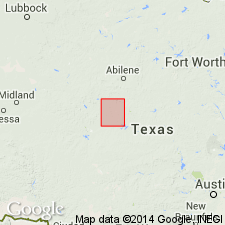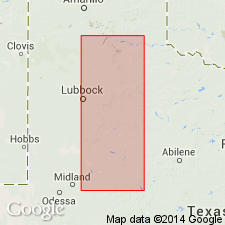
- Usage in publication:
-
- Blowout Mountain sandstone
- Modifications:
-
- Original reference
- Dominant lithology:
-
- Sandstone
- AAPG geologic province:
-
- Permian basin
Summary:
Pg. 95, 96, 98, pl. Blowout Mountain sandstone of Double Mountain group. Massive, dark red, coarse-grained, cross-bedded sandstone, 40 to 105 feet thick. Lies 0 to 25 feet above base of Greer Formation, being in places underlain by 20 to 25 feet of red clay, but in most places forms basal member of Greer Formation. [Recognized in Runnels and Taylor Counties, central northern Texas. Age is Permian.]
Named from exposure in Blowout Mountain, southwest of Merkel, Taylor Co., central northern TX.
Source: US geologic names lexicon (USGS Bull. 896, p. 216).

- Usage in publication:
-
- Blowout Mountain sandstone
- Modifications:
-
- Not used
- AAPG geologic province:
-
- Permian basin
Summary:
Pg. 7, 8. Blowout Mountain sandstone of Wrather (1917) is same as San Angelo beds of Lerch (named in 1891), and San Angelo will replace Blowout Mountain as name of this formation. It connects with Angelo beds.
Source: US geologic names lexicon (USGS Bull. 896, p. 216).

- Usage in publication:
-
- Blowout Mountain sandstone
- Modifications:
-
- Not used
- AAPG geologic province:
-
- Bend arch
- Permian basin
Summary:
Blowout Mountain sandstone is northern extension of San Angelo formation.
Source: US geologic names lexicon (USGS Bull. 896, p. 216).

- Usage in publication:
-
- Blowout Mountain sandstone†
- Modifications:
-
- Abandoned
- AAPG geologic province:
-
- Bend arch
- Permian basin
Summary:
Pg. 168. Blowout Mountain sandstone of Wrather (1917) discarded for San Angelo sandstone. San Angelo sandstone is basal unit in Double Mountain group, uppermost group of the Permian of north-central TX.
Source: US geologic names lexicon (USGS Bull. 896, p. 216); supplemental information from GNU records (USGS DDS-6; Denver GNULEX).
For more information, please contact Nancy Stamm, Geologic Names Committee Secretary.
Asterisk (*) indicates published by U.S. Geological Survey authors.
"No current usage" (†) implies that a name has been abandoned or has fallen into disuse. Former usage and, if known, replacement name given in parentheses ( ).
Slash (/) indicates name conflicts with nomenclatural guidelines (CSN, 1933; ACSN, 1961, 1970; NACSN, 1983, 2005, 2021). May be explained within brackets ([ ]).

